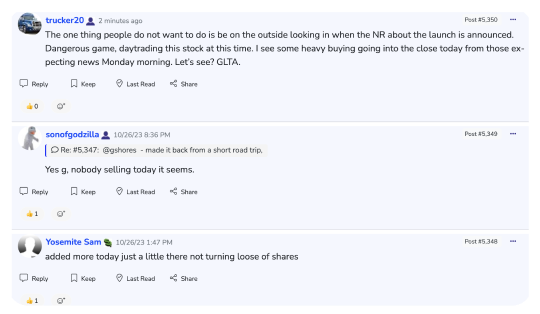| Followers | 826 |
| Posts | 119569 |
| Boards Moderated | 14 |
| Alias Born | 09/05/2002 |
Saturday, June 05, 2010 4:30:53 AM
Teva Reports Results for ‘Low-Volume’ Copaxone
[This study compared the standard formulation of Copaxone (20mg of drug infused in 1ml of fluid) to a new formulation with 50% less volume of fluid (20mg of drug infused in 0.5ml of fluid). Although this PR reports that the low-volume formulation produced statsig less pain and infusion-site reactions, I discount these findings because the trial was open-label, i.e. patients knew which formulation of Copaxone they were getting. Moreover, the low-volume formulation had 1.5x the rate of AE’s as the standard formulation (and, curiously, Teva does not furnish a p-value for the difference in the rate of AE’s).
The clinicaltrials.gov entry for the low-volume Copaxone trial is at http://clinicaltrials.gov/ct2/show/NCT00947752 . Based on the data reported in this PR, Teva submitted an sNDA in March, and the sNDA was accepted for FDA review on May 3 (#msg-49746622). The FDA is conducting a standard 10-month review, so the PDUFA date is in Jan 2011.
All told, I think the low-volume formulation of Copaxone is a marketing and patent-protection gimmick that confers little, if any, medical value. If NVS/MNTA eventually obtain FDA approval for generic Copaxone, Teva will presumably try to turn the low-volume formulation into the centerpiece of its franchise defense.]
http://finance.yahoo.com/news/Teva-Announces-Positive-bw-3942597871.html?x=0&.v=1
›Friday June 4, 2010, 12:52 pm EDT
JERUSALEM--(BUSINESS WIRE)--Teva Pharmaceutical Industries Ltd. (NASDAQ: TEVA) today announced positive results from a study assessing a new lower-volume injection of Copaxone® (glatiramer acetate) containing the currently approved dose in half the injection volume.
The SONG study (‘Study of New Glatiramer Acetate Formulation’) explored the safety and tolerability of a 20mg/0.5mL injection of Copaxone® versus the current formulation of 20 mg/1.0mL.
These findings were presented at the 24th Annual meeting of the Consortium of Multiple Sclerosis Centers (CMSC) in San Antonio, Texas.
“Copaxone® has proven long-term efficacy, safety and tolerability with more than one million patient years of treatment,” said Dr. Ronald Murray, FAAN, a lead study investigator and Director of the MS Clinic of Colorado. “We are encouraged by these data as they suggest that a 0.5mL dose of glatiramer acetate may enhance patients’ experience with the most frequently prescribed MS therapy.”
The SONG study enrolled 148 relapsing-remitting MS patients (RRMS) at 21 sites in the United States. Data demonstrated that both the 1.0mL and 0.5mL products were safe and well tolerated. Patients receiving the lower-volume injection reported significantly less pain immediately following and five minutes after administration (p<0.0001). Although the presence of injection site reactions (swelling, redness, itching, lumps) was not high for either group, patients reported fewer and less severe reactions within five minutes (p<0.0001) and 24 hours (p<0.0001) post-administration with the 20mg/0.5mL product. No serious adverse events were reported in the study.
“Copaxone® is the global market leading RRMS treatment, and Teva is continuously pursuing research focused on further enhancing the patient treatment experience with the product,” said Moshe Manor, Teva’s Group Vice President, Global Branded Products. “Our investment in research has already translated to increased benefits for Copaxone® patients, including an expanded indication to treat early-stage MS-like symptoms in patients at risk of progression to an MS diagnosis, as well as device improvements such as a thinner needle to reduce injection discomfort and an auto inject device to better facilitate treatment delivery.”
About the Study
Patients (N=148) enrolled in an open-label randomized two-arm single crossover study. Half of the patients (n=76) were randomized to inject 20mg/1.0mL daily for the first 14 day period (Period 1); the other half of the patients (n=72) injected 20mg/0.5mL daily during Period 1. During the second 14 day period (Period 2), the groups switched their injection volume formulation. Patients completed a daily diary reporting pain occurring immediately and at 5 minutes post injection, as well as the presence and severity of injection site reactions within 5 minutes and 24 hours of injection. Safety, tolerability, clinical and laboratory assessments occurred during the course of the study. Adverse events were reported by 12.5 percent of patients when injecting 20mg/1.0mL and by 18.1 percent of patients when injecting 20mg/0.5mL [oops!]. Overall, the AE profile of Copaxone in patients treated with either formulation was consistent with Copaxone's observed safety profile in placebo-controlled pivotal trials and post-marketing experience.‹
[This study compared the standard formulation of Copaxone (20mg of drug infused in 1ml of fluid) to a new formulation with 50% less volume of fluid (20mg of drug infused in 0.5ml of fluid). Although this PR reports that the low-volume formulation produced statsig less pain and infusion-site reactions, I discount these findings because the trial was open-label, i.e. patients knew which formulation of Copaxone they were getting. Moreover, the low-volume formulation had 1.5x the rate of AE’s as the standard formulation (and, curiously, Teva does not furnish a p-value for the difference in the rate of AE’s).
The clinicaltrials.gov entry for the low-volume Copaxone trial is at http://clinicaltrials.gov/ct2/show/NCT00947752 . Based on the data reported in this PR, Teva submitted an sNDA in March, and the sNDA was accepted for FDA review on May 3 (#msg-49746622). The FDA is conducting a standard 10-month review, so the PDUFA date is in Jan 2011.
All told, I think the low-volume formulation of Copaxone is a marketing and patent-protection gimmick that confers little, if any, medical value. If NVS/MNTA eventually obtain FDA approval for generic Copaxone, Teva will presumably try to turn the low-volume formulation into the centerpiece of its franchise defense.]
http://finance.yahoo.com/news/Teva-Announces-Positive-bw-3942597871.html?x=0&.v=1
›Friday June 4, 2010, 12:52 pm EDT
JERUSALEM--(BUSINESS WIRE)--Teva Pharmaceutical Industries Ltd. (NASDAQ: TEVA) today announced positive results from a study assessing a new lower-volume injection of Copaxone® (glatiramer acetate) containing the currently approved dose in half the injection volume.
The SONG study (‘Study of New Glatiramer Acetate Formulation’) explored the safety and tolerability of a 20mg/0.5mL injection of Copaxone® versus the current formulation of 20 mg/1.0mL.
These findings were presented at the 24th Annual meeting of the Consortium of Multiple Sclerosis Centers (CMSC) in San Antonio, Texas.
“Copaxone® has proven long-term efficacy, safety and tolerability with more than one million patient years of treatment,” said Dr. Ronald Murray, FAAN, a lead study investigator and Director of the MS Clinic of Colorado. “We are encouraged by these data as they suggest that a 0.5mL dose of glatiramer acetate may enhance patients’ experience with the most frequently prescribed MS therapy.”
The SONG study enrolled 148 relapsing-remitting MS patients (RRMS) at 21 sites in the United States. Data demonstrated that both the 1.0mL and 0.5mL products were safe and well tolerated. Patients receiving the lower-volume injection reported significantly less pain immediately following and five minutes after administration (p<0.0001). Although the presence of injection site reactions (swelling, redness, itching, lumps) was not high for either group, patients reported fewer and less severe reactions within five minutes (p<0.0001) and 24 hours (p<0.0001) post-administration with the 20mg/0.5mL product. No serious adverse events were reported in the study.
“Copaxone® is the global market leading RRMS treatment, and Teva is continuously pursuing research focused on further enhancing the patient treatment experience with the product,” said Moshe Manor, Teva’s Group Vice President, Global Branded Products. “Our investment in research has already translated to increased benefits for Copaxone® patients, including an expanded indication to treat early-stage MS-like symptoms in patients at risk of progression to an MS diagnosis, as well as device improvements such as a thinner needle to reduce injection discomfort and an auto inject device to better facilitate treatment delivery.”
About the Study
Patients (N=148) enrolled in an open-label randomized two-arm single crossover study. Half of the patients (n=76) were randomized to inject 20mg/1.0mL daily for the first 14 day period (Period 1); the other half of the patients (n=72) injected 20mg/0.5mL daily during Period 1. During the second 14 day period (Period 2), the groups switched their injection volume formulation. Patients completed a daily diary reporting pain occurring immediately and at 5 minutes post injection, as well as the presence and severity of injection site reactions within 5 minutes and 24 hours of injection. Safety, tolerability, clinical and laboratory assessments occurred during the course of the study. Adverse events were reported by 12.5 percent of patients when injecting 20mg/1.0mL and by 18.1 percent of patients when injecting 20mg/0.5mL [oops!]. Overall, the AE profile of Copaxone in patients treated with either formulation was consistent with Copaxone's observed safety profile in placebo-controlled pivotal trials and post-marketing experience.‹
Join the InvestorsHub Community
Register for free to join our community of investors and share your ideas. You will also get access to streaming quotes, interactive charts, trades, portfolio, live options flow and more tools.











